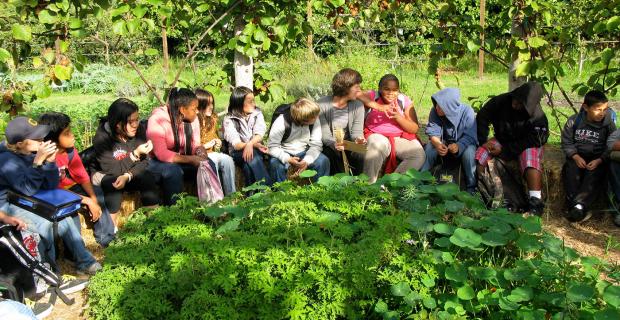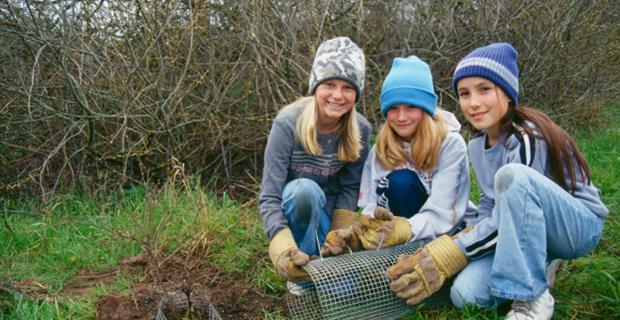Project-based Learning with Mushrooms

Bales of straw insulate the walls of the mushroom fruiting building at Laytonville High School.
The wiring and temperature controls inside were installed by students from the joint math/science classes. Excess wood from a local lumber mill provides the substrate for the mushrooms. And this school year, a new crop of students has begun tending the mushrooms inside, readying them for sale at a local natural food store across town. The mushroom business at Laytonville High School represents all of the key elements of a successful integrated ecological literacy program, along with other project-based learning that has been happening in Laytonville since the mid-1980s.
With the support of the Center for Ecoliteracy and other organizations, the teachers and community of Laytonville have found ways to integrate environmental awareness, learning, and community vitality into their curriculum and lives. The mushroom project is only one of the many activities in Laytonville's schools that incorporate these three central tenets, while teaching sustainability, recycling, and biology and bringing together community members.
David Sobel, codirector of the Center for Environmental Education at Antioch New England Graduate School in New Hampshire, has spent a lot of time thinking about the key elements for a successful environmental education program. "We've been talking about focusing on three things," Sobel says. "Academic achievement, including content in understanding ecosystems; there's also improving environmental quality, which is a separate goal; and community vitality and how you contribute to community vitality." Communication between these very different objectives is necessary, he says, and from what he has seen, the programs in Laytonville and other communities in the North Coast Rural Challenge Network (NCRCN) have achieved that.
Historically the economy and activity of the small unincorporated town of Laytonville centered around lumber. Now that the redwood trees have been depleted as a resource, the lumber industry and the community's lifestyle may be at risk. What the community needs is a new cash crop.
Laytonville's community educators are trying to teach Laytonville's next generation how to live sustainably in their ecosystem. Part of the mushroom project, said Bruce Potter, was figuring out how to show people, and the kids in particular, that there was an environmentally friendly way to make a living in the isolated town.
"The mushroom project is based on the idea of forestry practices," says Potter. "What have these practices of the past created? What do we do now? Do we set up another boom and bust cycle?"
Potter, 44, who says he is the whole science department for Laytonville High School, has been thinking about mushrooms for over 10 years. Once some questions were answered by his own and his students' research, he found a resource that fits sustainably into a landscape now emptied of redwoods: tanoak.
"Here people consider tanoak a fire hazard or use it for firewood," Potter said, "but it's a wasted resource the way people are viewing it." Potter and his students, however, could use it: once the local lumber mill takes the best wood, the waste wood could be used to grow mushrooms. "You could drill holes in it and grow shiitake outdoors" in mushroom logs, Potter said, as an example. "It's a really good model of recycling. Waste becomes byproduct: You get sawdust mulch after the mushrooms have used up all the nutrients in the wood, then you use it in the garden ... and get way more revenue with these trees instead of doing nothing with them."
In the classroom, in the field, and in the mushroom fruiting house, Potter has emphasized a basic understanding of systems and their feedback mechanisms. "There're just tons of raw scientific information on how these organisms interact," Potter said of the grow room. "The students are tuned into the effects, getting feedback from the mushrooms, and they're trying to fine-tune the environmental controls to favor this species and find their niche. They notice the insects, their lifecycles, and they start to get intimate and passionate with living systems."
While they are trying to understand the ecosystems in the mushroom fruiting room and gardens, the students recycle material as much as possible. "The more efficient it is at not having waste, the more productive it is," Potter says of ecosystems and the students' projects. "The ecosystems that are sustainable have those qualities."
The mushroom project serves as a metaphor for an ecosystem. Plus, Potter says, "we're trying to get the kids to behave as a system." By adding the exercise of running a business — called Incredible Edibles — the students give to their community and gain useful experience. The mushrooms and lettuce that they raise go to the Good Food Store, which is run by Jon Spitz. The mushrooms, Spitz said, are "beautiful and they sold really well." The store labels the produce as grown locally and sustainably by Laytonville High School students. "People like that when we tell them that," Spitz said.
The lettuce comes from the high school garden project, started in 1986 by Binet Payne and now run by other teachers. Payne now works on the Laytonville community garden and other educational projects. She laughs when she says that the middle school garden is currently run by Brian Bowles. Bowles, who is 26, was a high school student who planted some of the first redwood trees at the garden. "He did all the research for my vermiculture book," Payne said.
Bowles left Laytonville to attend college, and he is one of the few 20-somethings to return to the area to live and work. He now teaches science to 7th and 8th graders, in the same school district where he went to school, and where his parents both continue to teach.
Just as Potter is the science department at the high school, Bowles is about the same for the middle school. Potter and Bowles say they see the same students all the way through their educational processes. "It's really good, a real advantage because I get to build real relationships with the kids and I know exactly what they know," Potter said. He compares this to Waldorf schools, where, ideally, a class or main teacher stays with students for the first eight years.
At the moment, Bowles has the 6th - through 8th - graders planting garlic; they are competing to see who can produce the most, measured by weight. Each homeroom has planted their own bed, with plants no closer than 6 inches apart. The kids' enthusiasm, he says, is terrific.
"We're lucky in that our students come in knowing the natural world," Bowles says. "It would be different in a city setting, where the kids have a different understanding — and some social strengths that our kids won't have," he said, considering Laytonville's isolation from the outside world. Bowles himself went to Santa Rosa Junior College and then to the California Polytechnical Institute (CalPoly) in San Luis Obispo, where he majored in biology. "Because I grew up here, I'm more in the community," he says. Plus, he says, it shows the students that, "yes, you can leave and come back and do well."
As the students watch and learn as much as they can about ecosystems, the idea is that this next generation of Laytonville residents will gain a sense of stewardship and an understanding of how they themselves fit into their surroundings. "In a real way, these kids are seeing what happened and working with how you can be sustainable. How can we develop models for the future that will not be damaging to their resources?" Potter asks rhetorically. "This is their backyard, this is their resource, their parents' land."
Many of the students' parents work for Harwood Lumber, says Bowles, or have worked somehow in the lumber industry. It may be difficult for them to see what else their children could do as contributing members in the community, he says, but the idea is to teach the kids about balanced ecosystems and sustainable ways of harvesting a natural resource. "It's the problem with expectations of the parents' side, and trying to get kids to change, to get a trade, professional skill to contribute to the community," Bowles said, "and not being able to see outside the bubble of Laytonville, that there are other options out there."
Some of the families in the area can trace their roots in Laytonville back for several generations. In an effort to connect the students with their town's history, and to give older residents in town a chance to socialize (Laytonville does not have a senior center), Binet Payne initiated the "Elder Luncheons" project.
"The idea was to get down the history of our elders," said Annie O'Neill, "to allow students to see what our community is all about and talk to the elders about their history. One way to interact was the Elder Luncheon." The luncheon program is now in its third year, and it started in O'Neill's special education classroom with four students. Now 18 students work to prepare soup and breads, using vegetables from the organic garden just outside the classroom door. They also prepare the room where they will serve the Elders, as they are called, to look like a small restaurant. "The kids serve them," O'Neill said, "then the kids share stories and artifacts with the Elders."
O'Neill says that Penny Comer, whose family has lived in Laytonville for generations, gathers the older residents. "Penny contacts them all. She knows everyone, calls them, gets them to come by word of mouth. Because she lived here so long, she knows them all," O'Neill said.
The size of the community can be considered a strength with regard to teaching the philosophies, of education, environment, and community. Laytonville has a population of about 1500 residents, which includes approximately 600 children who attend school there. According to Binet Payne, the town is very tightly knit. "I think that the school is really representative of the community," she said. "We don't have a centralized government, or city council. People come to the school board meetings. There's really a lot of exchange between the community and the schools."
It's an advantage, according to Payne. Yet, she said, "there are also drawbacks because there's such a split between the environmental people and the sawmill people." Part of the community consists of people who moved to Laytonville during the back-to-the-land movement in the 1960s and 1970s.
Whether in a rural or urban area, what educator David Sobel calls "orientation" becomes important to how an environmental education is actually executed. "Orientation," he says, is "the right proportionality of environmental education to other things going on." Social history and a more traditional curriculum must be served in order to get broad acceptance for environmental education projects, and to serve the philosophies of the Center for Ecoliteracy and other organizations working to incorporate them into public schools. Sobel says that the three keys — academic achievement, improving environmental quality, and contributing to community vitality — have to be part of the core curriculum, as they are in Laytonville's schools. Environmental educators must be relatively full-time, exercises should be project-based, and the teachers and projects must have connections to the community, just as community issues must be part of the curriculum. Sobel says that these practices are essential for such projects "to work best in terms of the learning potential for kids."
Of the projects run by Laytonville and the NCRCN, Sobel says, "from what I can tell, looking at all these different projects around the country, it's one of the nicer ones, in terms of having the right blend of environmental orientation and community orientation."
Bruce Potter's students, growing mushrooms this year for class, will reap a multiple harvest: knowledge of their town's ecosystem, history, and future, and their own places in it.



